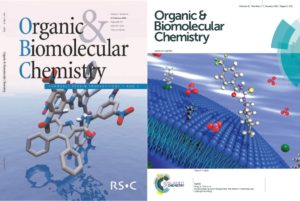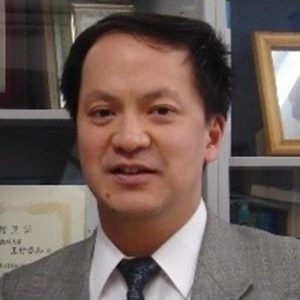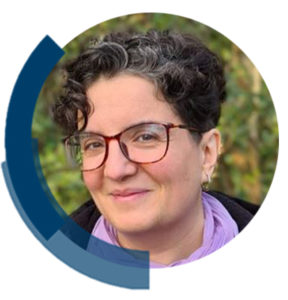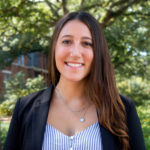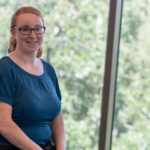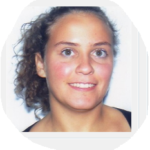2023 marks twenty years of Organic & Biomolecular Chemistry publications. As part of the celebrations, OBC has invited some of the most prominent authors across our history to give their thoughts on the last twenty years of their career alongside their predictions for the next two decades.
The next entry to the series comes from Professor Philip Gale at the University of Technology Sydney who first published with OBC in 2003, the journal’s first year. He has continued to support the journal with 21 articles across the years, most recently in 2023.
About Phil
 Phil Gale is the Deputy Dean of Science at the University of Technology Sydney. Phil was born and raised in Woolton, Liverpool (there are an unusually high number of academic chemists who originate from L25) and attended Gateacre Community Comprehensive School. He moved to the University of Oxford in 1988 to study Chemistry and remained there to undertake a DPhil under the supervision of Paul Beer in 1992. He moved as a Fulbright Scholar to the University of Texas at Austin in 1995 to work with Jonathan Sessler and subsequently was awarded a Royal Society University Research Fellowship which he took up at Oxford in 1997. While at Oxford, he co-wrote an Oxford Chemistry Primer on Supramolecular Chemistry with Paul Beer and David Smith which resulted in the Inorganic Editor of that series, Prof. John Evans from the University of Southampton inviting Phil down to give a seminar. Southampton offered Phil a continuing position as a Lecturer and Royal Society University Research Fellow, and he rose through the ranks becoming Professor of Supramolecular Chemistry in 2007 and serving as Head of Chemistry at Southampton between 2010 and 2016.
Phil Gale is the Deputy Dean of Science at the University of Technology Sydney. Phil was born and raised in Woolton, Liverpool (there are an unusually high number of academic chemists who originate from L25) and attended Gateacre Community Comprehensive School. He moved to the University of Oxford in 1988 to study Chemistry and remained there to undertake a DPhil under the supervision of Paul Beer in 1992. He moved as a Fulbright Scholar to the University of Texas at Austin in 1995 to work with Jonathan Sessler and subsequently was awarded a Royal Society University Research Fellowship which he took up at Oxford in 1997. While at Oxford, he co-wrote an Oxford Chemistry Primer on Supramolecular Chemistry with Paul Beer and David Smith which resulted in the Inorganic Editor of that series, Prof. John Evans from the University of Southampton inviting Phil down to give a seminar. Southampton offered Phil a continuing position as a Lecturer and Royal Society University Research Fellow, and he rose through the ranks becoming Professor of Supramolecular Chemistry in 2007 and serving as Head of Chemistry at Southampton between 2010 and 2016.
Phil then moved as Head of Chemistry to the University of Sydney in early 2017. He served as Head from 2017 to 2022 and Associate Dean International from 2020 to 2023. In April 2022 he became interim Dean of Science at Sydney and in February 2023, moved to the University of Technology Sydney as Deputy Dean of Science.
Phil and his research team have won several awards for their work including the RSC Bob Hay Lectureship, the Corday Morgan Medal and Prize, the RSC Supramolecular Chemistry Award and the 2018 Izatt-Christensen Award in Macrocyclic and Supramolecular Chemistry.
First OBC paper: S. Camiolo, P. A. Gale, M. B. Hursthouse & M. E. Light, Nitrophenyl derivatives of 2,5-diamidopyrroles: structural behaviour, anion binding and colour change signaled deprotonation, Org. Biomol. Chem., 2003, 1, 741-744, DOI: 10.1039/b210848h
Most recent OBC paper: M. Fares, X. Wu, D. A. McNaughton, A. M. Gilchrist, W. Lewis, P. A. Keller, A. Arias-Betancur, P. Fontova, R. Pérez-Tomás & P. A. Gale, A potent fluorescent transmembrane HCl transporter perturbs cellular pH and promotes cancer cell death, Org. Biomol. Chem., 2023, DOI: 10.1039/d3ob00128h
Favourite OBC paper: C. J. E. Haynes, N. Busschaert, I. L. Kirby, J. Herniman, M. E. Light, N. J. Wells, I. Marques, V. Félix & P. A. Gale, Org. Biomol. Chem., 2014, 12, 62-72, DOI: 10.1039/c3ob41522h
How has your research developed over the last 20 years?
When I began my independent career in the late 1990s with my own research group, many anion receptor systems reported in literature were structurally complex, containing macrocyclic components and often carrying a positive charge. We focused on simplifying the structures of these systems and reported a series of acyclic receptors, including 2,5-diamidopyrroles, ortho-phenylene-based bis-ureas, dipyrromethene bis-amides and 1,3-diamidoanthraquinones. We showed that simple acyclic receptors could still retain high affinity and selectivity for particular anions. My first paper in OBC was published in 2003 in the 4th issue of volume 1. At the time I was a relatively new academic at the University of Southampton in the UK, looking at designing hydrogen bond donor motifs to bind anions. We’d noticed that pyrrole 2,5-dicarboxamides containing electron-withdrawing groups would deprotonate upon addition of fluoride which in some cases would cause a colour change. At that time (and for a while after) there were many examples of colorimetric fluoride sensors reported in the literature – this paper together with contemporaneous work from Thorri Gunnlaugsson’s group at Trinity College Dublin demonstrated that the colour changes observed with these systems may also be due to deprotonation processes. We kept an eye out for these types of acid-base reactions and reported further examples over the following years – including in 2010 an example of a receptor containing multiple hydrogen bonds affecting the pKa of a bound anion resulting in deprotonation of the anionic guest.
Over the last twenty years we have stayed with the theme of anions but moved from designing receptors to designing and testing anionophores to facilitate the transport of anions across lipid bilayer membranes. This has been a collaborative effort with many colleagues including Tony Davis and David Sheppard in Bristol, Jeff Davis in Maryland, Bradley Smith at Notre Dame, Jonathan Sessler in Austin, Roberto Quesada in Burgos, Vitor Félix in Aveiro, Rob Elmes at Maynooth University, Kate Jolliffe at the University of Sydney, Yun-Bao Jiang at Xiamen University, Ricardo Pérez-Tomás at Barcelona, and Injae Shin at Yonsei University. My group has moved during this time, first to the University of Sydney in 2017 and this year to the University of Technology Sydney.
Early work focused on producing analogues of the natural product prodigiosin – one of the most potent HCl co-transporters known. However, as with our work on anion receptors, we simplified the design of anion transporters to understand the factors that govern efficient transport. Work focused both on encapsulating tripodal tris-ureas and -thioureas and planar single ureas, thioureas and squaramides that we demonstrated are very effective transporters when fluorinated. In 2013, we published a quantitative structure activity relationship study, showing that in a series of simple thioureas with one n-hexyl substituent and a phenyl substituent with different groups in the 4-position, the lipophilicity of the receptor is the dominant molecular parameter determining effective transport, with smaller contributions from the receptors’ volume and affinity for chloride.
With our collaborators, we’ve found that anion transport into cells can trigger apoptosis and interfere with autophagy and hence these compounds may potentially have anti-cancer properties. We’ve also demonstrated that our compounds can facilitate the transport of chloride across epithelial cell membranes. This is an interesting result as chloride transport is reduced or stopped across epithelial cell membranes in patients with cystic fibrosis. The development of chloride anionophores offers the prospect of replacing the faulty chloride channels in these cells with small molecules that can perform the same function. Our latest paper in OBC, published in 2023, twenty years after the first, is a collaboration with Ricardo Pérez-Tomás where we investigate where fluorescently tagged versions of one of the most effective anion transport motifs (ortho-phenylene bis-ureas) localise in cells.
How has the field of supramolecular chemistry changed over the last 2 decades?
The field of supramolecular chemistry has grown and developed significantly over the last 20 years. One of the most fascinating areas has been the development of systems chemistry and the study of dissipative self-assembly. The use of fuels to form transient assemblies far from equilibrium resembles processes found in biological systems with complex dynamic behaviour. Of course, one of the highlights of the last two decades has been the award of the Nobel Prize in Chemistry in 2016 to Jean-Pierre Sauvage, Fraser Stoddart and Ben Feringa for the development of molecular machines. Another pioneer in this area is Dave Leigh at the University of Manchester, whose work on molecular knots, synthetic chemically-fuelled molecular motors and molecular robotics is always inspiring with the ingenuity and elegance of his supramolecular creations. Another leader in supramolecular chemistry is Wolf prize winner Makoto Fujita at the University of Tokyo. A standout achievement for me has been Fujita’s development of crystalline sponges which allow micrograms of compounds to be soaked into crystals and subsequent X-ray structural determination. This has allowed single crystal X-ray diffraction structures of liquids and very small quantities of materials to be obtained.
I think importantly recently we have seen a generational shift in the field with many of the first generation of supramolecular chemists approaching retirement or having already retired, a new more diverse cohort of researchers is picking up the mantle. A positive international development has been the establishment of the Women in Supramolecular Chemistry network (www.womeninsuprachem.com) which is providing a support network for women and marginalised groups working in supramolecular chemistry. A growing recognition of the importance of supramolecular chemistry is reflected in the recent decision by the Royal Australian Chemical Institute to form a new division of supramolecular chemistry alongside the more traditional areas of chemistry.
Where do you see the challenges being for this field over the next 20 years?
Obtaining research funding is always challenging and supramolecular chemistry is at its core, a fundamental area of chemistry which requires discovery type support to make progress. However, I think it’s important that we as a field can point to applications of supramolecular chemistry in technological processes and in medicine. This will allow us to illustrate to funders and to our academic colleagues, the cross-cutting nature of supramolecular chemistry and the many real-world problems that can be addressed using supramolecular approaches. A group of us wrote a review1 in 2021 highlighting some of these which covered medicine, sensors, remediation of chemical warfare agents, hydrometallurgy, separations and extractions, environmental remediation, self-healing materials and coatings, adhesives, and batteries. The continued translation of supramolecular chemistry to technological applications in the real-world is vital for the long-term health of our discipline.
Check out the other entries in our blog series here!
1G. T. Williams, C. J. E. Haynes, M. Fares, C. Caltagirone, J. R. Hiscock & P. A. Gale, Advances in applied supramolecular technologies, Chem. Soc. Rev., 2021, 50, 2737-2763, DOI: 10.1039/d0cs00948b


